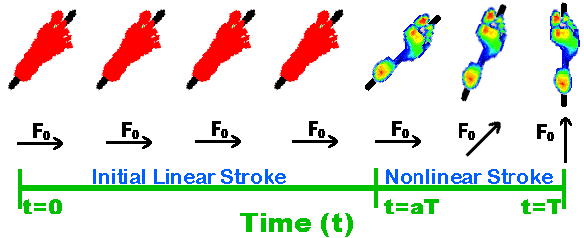How an Inline Skate Turns
c P. J. Baum
March 1999
Note Added 6-24-00-- See also Turning: Part
II
1. The Turning Path Of An Inline
Skate
| First I consider how a 5-wheel skate travels in "a circle"
and then consider the basic turning process itself. The figure on the
right shows five inline wheels leaning way left (exaggerated) with
red-black contact patches where the wheels flatten against the floor. When
the skate travels straight ahead along the blue line the contact patches
are nicely in line. So if the skate were to travel a curved path either
the contact patches must move out of line or the wheels must travel on
different curves. It would seem to take a lot of energy to deform the
wheels so that the contact patches move way out of line (unless you have
very soft wheels) so I think the case of cornering for a speedskater
follows the figure to the right.
The front wheel will be 1 and the rear wheel will be 5. So skating in a
fairly sharp circle (10 foot diameter, 5 foot radius) the curves which
pass through the middle wheel (3) and the curve which passes through 1 and
5 will be offset left-right by 0.3 inches or just over the size of the
axle hole in the center of a bearing. So the curves are much straighter
than they appear on my figure. If you slide there will be 5 curves instead
of 3 as each wheel gets its own path. When you complete the turn the wheel
paths will merge back to one if you move straight ahead. I am not aware of
any real data on wheel paths but this seems most reasonable. |
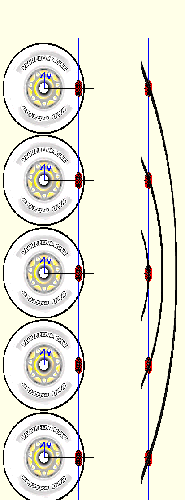
|
A 2-wheel skate will have only one wheel-trajectory curve if you use the most
efficient turn so it really can travel in a true circle. A 3-wheel skate and a
4-wheel skate will have only two curves. A 6-wheel skate will have three curves
like the 5-wheel. We assumed here that all the wheels on the skate are the same
size and shape.
2. How Does An Inline Wheel Turn?
Now that we have seen how the skate fits on a curved path it is time to
explain how the wheels themselves can roll off a straight path. I am not
concerned here with the hockey-slide type of turn or the type where all but one
wheel is off the ground as they are inefficient or lack sufficient control for
racing. To explain how the wheel turns we first need to know more about how they
grip.
2a. Background on Wheel Grip
You can make these ideas on grip much clearer by demonstrating them for
yourself. Locate a fairly new wheel which is soft. New means that it has a
curved profile and a smooth surface. If the wheel is worn it will be difficult
to observe the contact patches. If the wheel is hard it will be difficult to
apply enough force with your hands to produce the contact patches. Put
bearings in the wheel and slide a bolt through it and tighten a nut to hold
the wheel. You should be able to hold onto the bolt and easily roll the wheel.
Now find a piece of glass like an open window or glass table top where you
have simultaneous access to both sides of the glass. Roll the wheel on one
side of the glass and observe it from the other side. You should be able to
see the contact patch where the wheel flattens against the glass. Get familiar
with where the patch moves as you lean the wheel on edge. The wheel rolls
ahead very easily. Now try to push or pull it in the direction of the bolt. If
your wheels are like mine they have a pretty strong grip against sliding
sideways. As you lay the wheel on edge (say 45 degrees) the sliding grip stays
fairly strong. Now put the wheel straight up again and rotate the bolt in a
circle parallel to the glass surface. It rotates fairly easily. Put the wheel
on edge (45 degrees) and again the rotational grip is much weaker than
the sliding grip.
Now get a pen and mark a small arrow on the bottom of the wheel (small
enough to fit inside the contact patch if you were standing straight up on
your skates). Point the arrow parallel to the bolt. Roll the wheel straight
ahead and the arrow should maintain its direction as it rolls through the
contact patch. This is how a wheel ought to behave. Right?
Ok, now mark an arrow farther on the side so it will fit into the contact
patch when you place the wheel on edge at a 30-45 degree angle. Now roll the
wheel straight ahead while it is on edge at the angle which will allow the
arrow to contact the glass as it rolls. If you press the wheel against the
glass lightly the arrow rotates as it passes through the contact patch. If you
press hard the arrow stays at the angle it had when it entered the contact
patch and then rotates quickly after it exits the contact patch. I conclude
that if the wheel on edge is gripping rotationally, a torsional stress is
built up on the surface of the wheel even as it rolls straight ahead!
This torsional stress starts as the arrow enters the contact patch and
builds up to a maximum as it exits the contact patch. The level of torsional
stress which can be built up can be controlled by the pressure you apply to
the wheel. That is, the skater can determine when the rotational grip fails by
selectively applying foot pressure. Because the sliding grip is so much
stronger than the rotational grip the skater can probably modulate the
rotational grip without destroying the sliding grip. Although it is possible
that if you really push the turns, applying a lot of force, that when the
rotational grip fails the torsional waves sent out from the point of failure
may weaken the sliding grip locally. In this case both the rotational and
sliding grip would be lost at the rear of the contact patch and would appear
to move forward, toward the leading edge of the contact patch where the
torsional stress is lowest.
2b. The Turning Process
The left side of the figure below shows the wheel (and skate) moving
straight ahead. The right side shows the proposed change during turning.
Left: The wheel is viewed from above looking down at the floor. The wheel
is leaning way left (exaggerated). The wheel and skates move straight ahead
along the blue line and the blue vector at the wheel axis shows the forward
velocity there. The wheel makes contact with the floor at the red contact
patch. The rotational grip patch is shown as black treadmarks. Note that the
wheel as a whole moves forward at the speed v and every point on the periphery
of the wheel (actually here a circle through the contact patch with center at
the axle) moves with velocity v relative to the axle rotating around it. So
long as the grip patch remains centered on the horizontal black line
(connecting the axles on the left and right) the wheel and frame move straight
ahead. Here the rotational component of velocity points directly behind the
skater (down on the figure) but if you move the grip patch up or down just a
little off the axle line there is a net horizontal velocity to the right or
left.
The right side of the figure below shows the grip patch moved up a little
or rotated forward through a small angle marked by the red line connecting the
axle center with the grip patch center. Now the net velocity seen by the
contact patch has a slight rightward rotational velocity which moves the wheel
a little to the left.
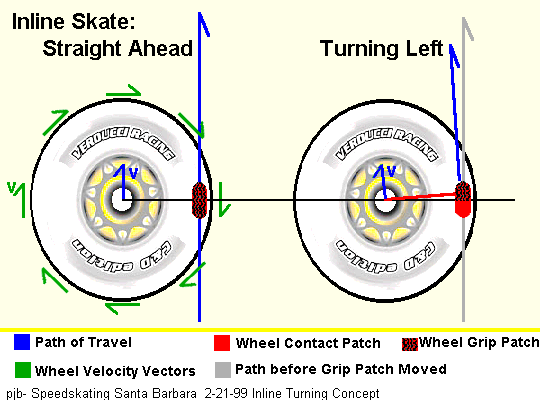
3. Comments
It is this forward motion of the rotational grip (loss of the grip on the
back portion of the contact patch where the torsional stress is largest) which
allows the wheel to use the sideways motion of the wheel on edge to turn. Not
surprisingly the turn is initiated by leaning to one side which builds up a
torsional stress in the wheel's contact patch. When the rotational grip fails
toward the trailing edge of the contact patch (through judicious choice of wheel
compound, surface, speed ... or by judicious application of foot pressure) the
grip moves forward and the skate turns.
There are a lot of complications which I will only point out briefly -- the
contact patch cannot be formed or removed instantaneously. So when you move fast
enough the contact patch length is not the same as you see at very low speeds.
For car tires this effect is related to traction waves which distort the tire
surface. For cars there is also a torsional wave but it is treated as separate
from the traction wave because car tires do not lean on edge very far. For
inline skate wheels on edge these waves are linked so at high speed the contact
patch would be tied to torsional-traction-waves in an even more complex manner
than car tire theory.
With the above understanding of turning it is not clear that the five-wheel
skate is at any disadvantage over the 2-wheel skate for turning. The
rolling-resistance and turning-resistance will be different for both but which
is lowest needs more study. The two-wheel skate still has the advantage that
larger diameter wheels can be used with their lower rolling-resistance. Would
the losses be still lower for a hybrid skate with 2 large wheels in front-back
and two or three regular wheels in between?
4. Acknowledgments
I appreciate helpful communications with Duncan Browne of the Inline Skating
Newsgroup and from Dean Jackson of the Inline Racing Newsgroup. I found the
series on The Physics of Racing--car racing-- by Brian Beckman to be
helpful, especially Part 10: Grip Angle-- available on at least three
servers on the internet.
Forward Stroking For Greater
Efficiency
c. P.J. Baum, October
1999.
Introduction
Earlier I found that the efficiency of the sideways linear (straight-line,
fixed-angle) stroke was only 50%. Here I examine the efficiency of a whole class
of linear strokes of different angles finding efficiency geater than 50% for
forward strokes and less than 50% for backward strokes. Still, the best stroke I
have found is not a single linear stroke but involves a transition between two
linear strokes -- one nearly sideways and one nearly forward.
Most
skating is done in an attempt to accelerate the skater forward, but speedskating
tries to accomplish this goal more powerfully and efficiently than other kinds
of skating. Here I examine some of the strokes in the skater's toolbox for power
and efficiency. The figure below shows how I would break stroking into three
regions: backward, sideways, and forward.
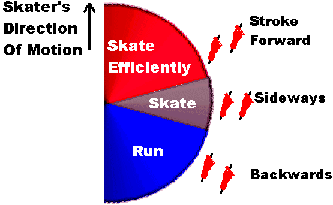
Starting from the blue sector of the figure above, the skater basicly
runs on his skates for the start. This backward stroke works well when you are
at very low speed but propels the body forward at the expense of leaving the
skate and leg behind in the dust. Moving the skate forward for the next stroke
undoes a lot of the work you just did. Because of the inefficiency of the
backward stroke the skater soon enters the gray "skate" region where the stroke
is pretty much sideways. The skater spends a lot of time in this region where
the skate now just keeps up with the skater's body. You push sideways and the
skate is generous enough to convert half your work into forward motion retaining
only the other half as its fee. The attempt to cajole the skate into giving up
the other half of your energy is the subject of forward stroking which is the
red region of the figure I labelled "skate efficiently". But before I look at
the efficiency of forward stroking it should be pointed out that there are (at
least) two types of forward strokes. I view them as passive and active.
- The passive forward stroke has as its goal the regaining of the 50% of the
stroke energy which was directed sideways. This is accomplished by "turning
the steering wheel" or "coasting the corner" so that the skate is turned
forward at the end of the sideways stroke. Now the sideways energy is turned
forward through reaction of the skate with the ground. This is really a power
control stroke and not a power generation stroke like the sideways push was.
It is difficult to determine the efficiency of this power control process but
my observation of short track skaters suggests that the loss must be fairly
small. In fact, the efficiency is complicated by the active forward stroke: a
good skater actually accelerates around the corner rather than just
maintaining his/her speed.
- So the active forward stroke has as its goal the production of another
10-30% energy while "powering the corner" at the end of the sideways stroke.
This energy is in addition to the two 50%s already gained.
Efficiency Of Active Forward
Stroking
The figure below shows a skater's right foot and skate in relation to the
force, F, the skater applies in an attempt to move forward. In the general case
two angles are involved but to save space here I will discuss only a simpler
case which has all the important elements but only one angle involved. For this
case I have assumed that the angle between the skate and the forward direction
equals the angle between the applied force and the skate. The left side of the
figure shows the zero degree limit where the skate is pushed straight ahead. The
right side shows the 45 degree case where you push directly sideways and move
straight ahead. The arbitrary angle case is in the middle.
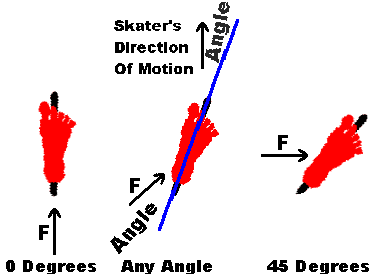
The solution is not difficult for this model and I have plotted the
results below for energy (or power) efficiency. Pushing the skate straight ahead
delivers all your energy to the skate (100% efficient) as you might expect.
Pushing sideways delivers the 50% efficiency I found earlier. What is novel is
that you can push for an unexpectedly large range of angles around the forward
direction and still maintain an efficiency in the 90% range (the angle between
the applied force and the forward direction is twice the angle plotted here so
this range is even greater than it appears). Also, the efficiency of backward
stroking (angles greater than 45 degrees) is less than 50%.
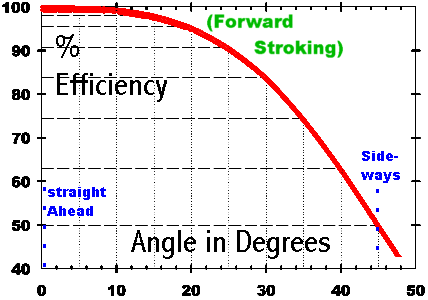
The advantage of the active forward stroke is that you can skate up
to small angles , not too far from straight ahead, and still react against the
ground for power generation but not develop a lot of sideways energy to cut your
efficiency. The disadvantage is exactly the opposite of the backward stroke.
When stroking backwards your body gets ahead of your skates and while stroking
forward you skates get ahead of your body. So start out conservatively or you
may land on your backside. The forward stroke requires that your body be moved
up to your skates for the next stroke. The situation is the same in the double
push where the forward push is handled with body shifts, rotations, or thrusts
depending on style. However, it seems a little harder to shift the body forward
over the skates in the single-push (classic) style as the body is not so easily
rotated in that case. Because of this limitation the amount of forward push is
not too great and is best used briefly -- for example as the termination of a
standard sideways push to develop additional forward thrust (see drawings here).
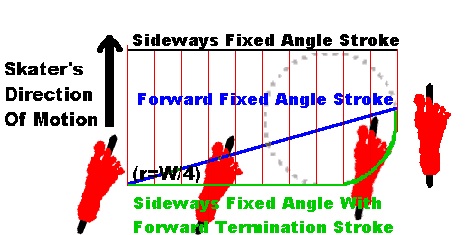
Since the efficiency of the forward stroke is greater than the sideways
stroke it is tempting to try to use it exclusively. This turns out not to be
advantageous because the shortest distance between two points is a straight
line. That is, any linear stroke will have a short stroke path length so that
although the efficiency may be high, the amount of energy generated along the
short path is not maximum. The figure above shows a forward fixed-angle stroke
and also a transition from a sideways to a forward stroke which ends at the same
point. It seems fairly obvious that the path length of the linear stroke is
shorter than the sideways-forward stroke so it will generate less energy. On the
question of efficiency, the termination of the sideways stroke with the forward
stroke rehabilitates the sideways stroke so that its overall efficiency will be
comparable with or possibly exceed that of the single linear forward stroke.
Finally there are some conclusions to be drawn from the efficiency model
used here. Recall these efficiencies: sideways 50%, forward 100%, midway between
these ~90% (push 45 deg. off forward with skate 22.5 deg. from forward). So by
pushing at 45 degrees from forward you gain 40% over sideways but at straight
ahead you gain only an additional 10%. In other words you don't need to push
anywhere near straight ahead to get a very high efficiency (90%). This allows an
interesting possibility for stroke termination -- by terminating the stroke past
straight ahead (around the corner and back toward the center line at a 45 degree
angle) you can extend the stroke path length even further -generating even more
energy- and suffer only a 10% drop in efficiency. This in fact seems to happen
in the double push. I haven't worked out the overall result of this but it does
have the advantage that the 10% "lost" energy due to inefficiency is used to
move the skate back to the center line presumably resulting in a decreased
interstroke time -- i.e. a faster stroke rate along with a possibly increased
overall forward power due to the increased stroke path length.
"Exact" Nonlinear Stroke Model
c. P.J. Baum, December 1999.
11/25/99
1. Introduction
On an earlier page I had discussed coupling a linear sideways stroke with a
forward turning stroke to increase the energy output of a skating stroke. Such a
situation is shown below where the sideways skate angle and stroke position are
shown as the right foot moves to the right. The analysis was an estimate only
and the intent of this page is to quantitatively describe the stroke. The word
"Exact" in the title is in quotes because when all is said the solution turns
out to be close to the one we wanted but not quite the same. Nevertheless, the
solution is highly instructive and points to the correct answer for several
questions.
2. The Stroke Model
In the figure below the proposed stroke is shown with time now plotted across
the bottom and not distance as before. The stroke is completed in time T and
begins with a linear stroke (red feet) from time t=0 up to t=aT where a is some
number between zero and one to be determined. After that time the stroke is
completed with a nonlinear turning stroke (multicolored feet).
The direction of the force (F0) the skater applies is also shown. The force
model comes from a forward-stroking
model I used earlier where the problem is reduced to only one angle because
the angle between the force and the skate is equal to the angle between the
skate and the direction of motion (forward)-- see below.
The stroke starts out sideways and turns to straight ahead (Angle starts at
45 degrees and turns to 0 degrees). So The turning stroke is modelled as a
sequence of linear strokes of different angle. No cornering properties of the
skate or wheels is included but the force splitting is based on an absence of
linear sliding. It turns out, that the linear stroke always loses (in this model
anyway) and that the skate ends the stroke at highest velocity for a=0 (no
linear portion at all). So the solution now becomes simpler with only a
nonlinear portion. The skate angle as a function of time, t,
is:
Angle(t) = [Pi/4]*[1-t/T]
where Pi/4 is 45 degrees expressed in radians. Now the model has the
forward force varying as cos(Angle)^2 while the sideways force varies as
sin(Angle)^2. So the terminal forward speed of the skate will be given by a time
integral of cos(Angle)^2.
2a. Results: Stroke Efficiency With A
"Simple Pull"
The exact solution to the integral equation for forward velocity
is:
vf(t)=[F0/2M]*[t-{2T/Pi}*{cos(Pi/2*t/T)} +2T/Pi]
which has as its value at t=T
vf(T) = [F0*T/M]*[1/2 +1/Pi]=0.818*[F0*T/M]
So this model ended up with 81.8% of the maximum velocity
available or 66.9% of the maximum energy available (vf ^2). This is a
little disappointing but the reason for only a modest improvment over a linear
stroke becomes clearer when we find that at time t=T that the sideways energy
has not dropped to zero.
In fact, the force must be applied for an additional 8 degrees (turning
back toward the skater's center line) before the sideways energy drops to
zero. Then the forward velocity increases to 91.9% of the maximum
available and the energy increases to 84.5% (even when the additional
energy input from the longer stroke time is considered). If you look at the
force arrows in the diagrams above only outward push forces were
applied and it was not until an inward "simple pull" force was used
(for the additional 8 degrees) that the sideways motion was really halted. We
had to oversteer the skate to get it to fully turn the corner. So this model
is for a skate/skater with very poor cornering characteristics.
2b. Efficiency Using A "Complex
Pull"
2b1. How the "Complex Pull" Results from
the "Cornering Force"
The model above is rather like a poor-handling car where the cornering
can be improved by taking advantage of the tire's "Grip Angle" or "cornering
force" [The
Physics of Racing, Part 10: Grip Angle by Brian Beckman]. As Beckman
explains, turning the steering wheel does not necessarily turn the car
unless a real force (cornering force) is developed to pull the tire into the
turn. The difference between the direction you steered and the direction the
car moves is the "grip angle" and it will be near zero for a car which
handles well. This cornering force is due to a differential grip across the
tire's contact patch caused by the torsional stress on the tire and is
independent of any linear (sideways) sliding or "slip". Unfortunately I have
found no quantitative theory or model for the cornering force so I can only
describe it qualitatively at this time. The figure below shows the turning concept I
developed earlier for the inline skate wheel. The normal "push" force has
caused the skate to move straight ahead along the blue line in the left
panel and here the grip (tread pattern) is uniform throughgout the contact
patch. As the skater executes the turn in the right panel the torsion
increases in the contact patch causing the grip to move forward. This
results in the wheel being "pulled" left away from the direction a linear
"push" would move it.

Inline skate cornering has not progressed beyond the qualitative model so
no quantitative results for efficiency can be obtained now. It may be noted
however, that the pull from the cornering force develops a velocity
component perpendicular to the skate which is absent in the linear push.
This force first pulls the skate forward, assisting the push in propulsion,
and then pulls the skate back to the skater's center line shortening the
stroke time.
On ice or snow the cornering force is developed through the "carving turn"
whereas on inlines the skater manipulates the wheel's contact patches to
develop the cornering force. The skater pushes down with the heel to enlarge
the rear contact patch and increase its torsion while rolling. The larger
contact patch means the turn can be sharper if enough torsion is developed.
In addition the outward heel push increases the rear wheel's contact patch
torsion still more and the result is the cornering force which pulls you
around the corner while the push helps the skate ahead.
3. Summary And Conclusions
- The analysis began with a linear stroke coupled to a nonlinear stroke.
Soon only the nonlinear stroke was retained because the linear stroke
always provided less forward propulsion within the parameters of this
model.
- Consequently it looks like the stroke should always be turning
(forward).
- The nonlinear stroke was modelled as a sequence of (turning) linear
strokes of various angle. This gave a velocity efficiency of 82% and an energy
efficiency of 67%.
- When a simple pull force was added to the stroke to halt the sideways
motion the velocity efficiency increased to 92% and the energy efficiency to
85%.
- The desired complex pull force (which experienced skaters seem to use) was
identified as the cornering force which relies on torsional effects in the
contact patch of the skate wheels.
- A qualitative model for the cornering is available but not a quantitative
one.
- Since the linear (sideways) push force produces sideways and forward
motion of the skate it can only use 50% of the skater's power to produce
forward propulsion. To increase the forward power it looks desireable to use
the cornering pull force to provide more propulsion (possibly nearly the other
50% of the skater's power).
- The reason it has taken so long to identify the pull force is because the
push, the turn, and the pull all occur simultaneously in the nonlinear stroke.
The skater provides the push and the skater-skate-ground interaction converts
part of the push into the pull.
- To nail down the maximum efficiency quantitatively will require an
accurate model for the skate's cornering force.






